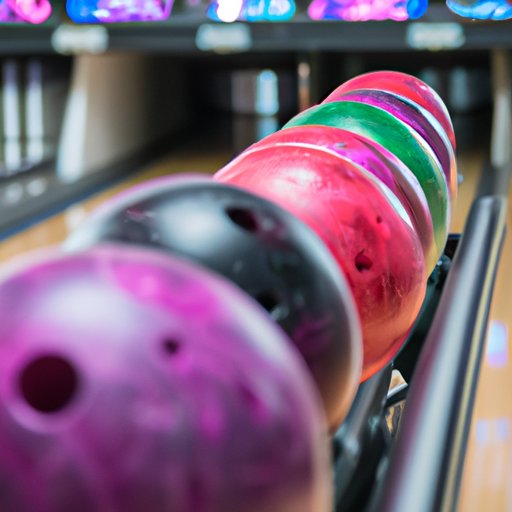
I. Introduction
For many people, throwing a bowling ball can feel like a daunting task. Whether you’re new to the sport or trying to improve your game, it can be challenging to know where to start. In this guide, we’ll break down the fundamentals of throwing a bowling ball and offer tips and techniques for success.
II. The Fundamentals of Throwing a Bowling Ball
Before we dive into the specifics of throwing a strike, it’s essential to understand the basic mechanics of a bowling throw. First, let’s talk about proper stance, grip, and arm swing.
Your feet should be shoulder-width apart, with your non-dominant foot slightly ahead of the other. Your grip should be firm but relaxed, with your fingers spread wide enough to grip the ball comfortably. As you begin your arm swing, keep your elbow close to your body and your wrist firm.
Practicing these fundamentals regularly will help you develop muscle memory, making it easier to throw consistent shots.
III. Mastering the Release: A Guide to Throwing a Strike
The release is arguably the most crucial part of a bowling throw. To achieve a hook shot, you’ll need to release the ball with a specific motion.
As you release the ball, rotate your wrist from the 10 o’clock to the 6 o’clock position, keeping your fingers behind the ball. This motion will create a hook shot, allowing the ball to curve towards the pins and increase your chances of a strike.
For more power and accuracy in your release, try to release the ball with a smooth, fluid motion, following through with your arm to maximize the speed and revs on the ball.
IV. Breaking down the Bowling Alley: Tips on How to Throw a Perfect Ball
While focusing on your mechanics is essential, it’s also crucial to pay attention to the lane. Understanding how oil patterns affect ball movement and learning how to adjust your throw for different lane conditions can give you an extra edge.
To read the lane, look for patterns in the oil on the lane, and adjust your throw accordingly. For example, if you see oil concentrated on the outside of the lane, try to throw the ball towards the center to take advantage of the drier lane conditions. Conversely, if there’s more oil in the center of the lane, try to throw the ball towards the outside.
Keep in mind that different lane conditions will call for different throwing styles. For example, if the lane conditions are dry, you may need to throw the ball harder to create more hook, while in oilier conditions, a slower, more controlled throw may be more effective.
V. Finding Your Style: Different Techniques for Throwing a Bowling Ball
While there’s no one-size-fits-all approach to throwing a bowling ball, different styles can offer advantages for different bowlers. Three of the most common styles are the stroker, the cranker, and the tweener.
A stroker is a bowler who throws the ball straight towards the pins, using a controlled, consistent motion. This style is ideal for bowlers who prefer accuracy over power.
A cranker, on the other hand, throws the ball with a faster, more forceful motion, creating high revs and significant hook. This style generates a lot of power and can lead to high scores, but it requires significant strength and control.
The tweener is a style that falls somewhere in between the two, utilizing a combination of power and accuracy to achieve consistent throws. As the name suggests, it’s a hybrid of the stroker and cranker styles.
Try experimenting with each of these styles to find the one that works best for your preferences and abilities.
VI. From Beginner to Pro: A Step-by-Step Guide to Throwing a Bowling Ball
Putting all the pieces together, let’s break down a step-by-step guide to throwing a successful bowling ball. Keep in mind that some steps may vary depending on your throwing style and lane conditions.
- Begin with proper foot placement, with your non-dominant foot slightly ahead.
- Hold the ball with a firm but relaxed grip, making sure your fingers are spread comfortably wide.
- Begin your arm swing, keeping your elbow close to your body and your wrist firm.
- As your arm reaches the peak of your swing, release the ball with a smooth, fluid motion.
- Follow through with your arm, maximizing speed and revs on the ball.
- Adjust your throw for lane conditions and your preferred throwing style.
- Repeat steps 1-6 consistently, practicing regularly to develop muscle memory and improve your game.
VII. Strike Every Time: Tips and Tricks for Consistent Bowling Ball Throws
To develop consistent throws, keep a few extra tips and tricks in mind. First, focus on your target, visualizing the path you want the ball to take and keeping your eyes on your target throughout your approach and release.
Additionally, maintaining a steady pace throughout your throw can help you keep your form consistent and improve your overall accuracy.
Finally, remember that practice is key to perfecting your bowling ball throw. Set aside regular practice time, either on your own or with a league or group, to hone your skills and improve your game.
VIII. Conclusion
Throwing a successful bowling ball takes practice, patience, and persistence, but with the right techniques and dedication, anyone can improve their game. To recap, start by mastering the fundamentals of the bowling throw, then work on developing your release, paying attention to lane conditions, and experimenting with different styles. With consistent practice and focus, you’ll be achieving strikes every time before you know it.
Remember, it’s never too late to start improving your bowling game. Whether you’re a beginner or a pro, there’s always room to grow and learn.




